
IndexClick on SDG title to access sections of interest
| SDG Number | SDG title |
| 1 | End poverty in all its forms everywhere |
| 2 | End hunger, achieve food security and improved nutrition and promote sustainable agriculture |
| 3 | Ensure healthy lives and promote well-being for all at all ages |
| 4 | Ensure inclusive and equitable quality education and promote lifelong learning opportunities for all |
| 5 | Achieve gender equality and empower all women and girls |
| 6 | Ensure availability and sustainable management of water and sanitation for all |
| 7 | Ensure access to affordable, reliable, sustainable and modern energy for all |
| 8 | Promote sustained, inclusive and sustainable economic growth, full and productive employment
and decent work for all |
| 9 | Build resilient infrastructure, promote inclusive and sustainable industrialization and
foster innovation |
| 10 | Reduce inequality within and among countries |
| 11 | Make cities and human settlements inclusive, safe, resilient and sustainable |
| 12 | Ensure sustainable consumption and production patterns |
| 13 | Take urgent action to combat climate change and its impacts |
| 14 | Conserve and sustainably use the oceans, seas and marine resources for sustainable development |
| 15 | Protect, restore and promote sustainable use of terrestrial ecosystems, sustainably manage
forests, combat desertification, and halt and reverse land degradation and halt biodiversity loss |
| 16 | Promote peaceful and inclusive societies for sustainable development, provide access to justice for
all and build effective, accountable and inclusive institutions at all levels |
| 17 | Strengthen the means of implementation and revitalize the Global Partnership for
Sustainable Development Finance |
|
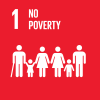
Goal 1. End poverty in all its forms everywhere  |
| Goals & targets | Indicators |
| 1.1 By 2030, eradicate extreme poverty for all people everywhere, currently measured as people living on less than $1.25 a day | 1.1.1 Proportion of population below the international poverty line, by sex, age, employment status and geographical location (urban/rural) |
| 1.2 By 2030, reduce at least by half the proportion of
men, women and children of all ages living in poverty
in all its dimensions according to national definitions | 1.2.1 Proportion of population living below the
national poverty line, by sex and age
1.2.2 Proportion of men, women and children of all
ages living in poverty in all its dimensions according
to national definitions |
| 1.3 Implement nationally appropriate social protection
systems and measures for all, including floors, and by
2030 achieve substantial coverage of the poor and the
vulnerable | 1.3.1 Proportion of population covered by social
protection floors/systems, by sex, distinguishing
children, unemployed persons, older persons, persons
with disabilities, pregnant women, newborns, workinjury
victims and the poor and the vulnerable |
| 1.4 By 2030, ensure that all men and women, in
particular the poor and the vulnerable, have equal rights
to economic resources, as well as access to basic services,
ownership and control over land and other forms of
property, inheritance, natural resources, appropriate new
technology and financial services, including microfinance | 1.4.1 Proportion of population living in households
with access to basic services
1.4.2 Proportion of total adult population with secure
tenure rights to land, with legally recognized
documentation and who perceive their rights to land as
secure, by sex and by type of tenure |
| 1.5 By 2030, build the resilience of the poor and those
in vulnerable situations and reduce their exposure and
vulnerability to climate-related extreme events and
other economic, social and environmental shocks and
disasters | 1.5.1 Number of deaths, missing persons and persons
affected by disaster per 100,000 peoplea
1.5.2 Direct disaster economic loss in relation to
global gross domestic product (GDP)a
1.5.3 Number of countries with national and local
disaster risk reduction strategiesa |
| a An open-ended intergovernmental expert working group on indicators and terminology relating to disaster risk reduction established by the General Assembly (resolution 69/284) is developing a set of indicators to measure global progress in the
implementation of the Sendai Framework. These indicators will eventually reflect the agreements on the Sendai Framework
indicators.
Report of the Inter-Agency and Expert Group on Sustainable
Development Goal Indicators (E/CN.3/2016/2/Rev.1)
3/25 |
| 1.a Ensure significant mobilization of resources from
a variety of sources, including through enhanced
development cooperation, in order to provide adequate
and predictable means for developing countries, in
particular least developed countries, to implement
programmes and policies to end poverty in all its
dimensions | 1.a.1 Proportion of resources allocated by the
government directly to poverty reduction programmes
1.a.2 Proportion of total government spending on
essential services (education, health and social
protection) |
| 1.b Create sound policy frameworks at the national,
regional and international levels, based on pro-poor and
gender-sensitive development strategies, to support
accelerated investment in poverty eradication actions | 1.b.1 Proportion of government recurrent and capital
spending to sectors that disproportionately benefit
women, the poor and vulnerable groups * |
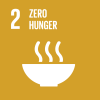
Goal 2. End hunger, achieve food security and improved nutrition and promote sustainable agriculture |
| Goals & targets | Indicators |
| 2.1 By 2030, end hunger and ensure access by all
people, in particular the poor and people in vulnerable
situations, including infants, to safe, nutritious and
sufficient food all year round | 2.1.1 Prevalence of undernourishment
2.1.2 Prevalence of moderate or severe food
insecurity in the population, based on the Food
Insecurity Experience Scale (FIES) |
| 2.2 By 2030, end all forms of malnutrition, including
achieving, by 2025, the internationally agreed targets on
stunting and wasting in children under 5 years of age,
and address the nutritional needs of adolescent girls,
pregnant and lactating women and older persons | 2.2.1 Prevalence of stunting (height for age <-2
standard deviation from the median of the World
Health Organization (WHO) Child Growth Standards)
among children under 5 years of age
2.2.2 Prevalence of malnutrition (weight for height
>+2 or <-2 standard deviation from the median of the
WHO Child Growth Standards) among children under
5 years of age, by type (wasting and overweight) |
| 2.3 By 2030, double the agricultural productivity and
incomes of small-scale food producers, in particular
women, indigenous peoples, family farmers, pastoralists
and fishers, including through secure and equal access to
land, other productive resources and inputs, knowledge,
financial services, markets and opportunities for value
addition and non-farm employment | 2.3.1 Volume of production per labour unit by
classes of farming/pastoral/forestry enterprise size
2.3.2 Average income of small-scale food producers,
by sex and indigenous status |
| 2.4 By 2030, ensure sustainable food production
systems and implement resilient agricultural practices
that increase productivity and production, that help
maintain ecosystems, that strengthen capacity for
adaptation to climate change, extreme weather, drought,
flooding and other disasters and that progressively
improve land and soil quality | 2.4.1 Proportion of agricultural area under
productive and sustainable agriculture |
| Report of the Inter-Agency and Expert Group on Sustainable
Development Goal Indicators (E/CN.3/2016/2/Rev.1)
4/25 |
| 2.5 By 2020, maintain the genetic diversity of seeds,
cultivated plants and farmed and domesticated animals
and their related wild species, including through soundly
managed and diversified seed and plant banks at the
national, regional and international levels, and promote
access to and fair and equitable sharing of benefits arising
from the utilization of genetic resources and associated
traditional knowledge, as internationally agreed | 2.5.1 Number of plant and animal genetic resources
for food and agriculture secured in either medium or
long-term conservation facilities
2.5.2 Proportion of local breeds classified as being at
risk, not-at-risk or at unknown level of risk of
extinction |
| 2.a Increase investment, including through enhanced
international cooperation, in rural infrastructure,
agricultural research and extension services, technology
development and plant and livestock gene banks in order
to enhance agricultural productive capacity in developing
countries, in particular least developed countries | 2.a.1 The agriculture orientation index for
government expenditures
2.a.2 Total official flows (official development
assistance plus other official flows) to the agriculture
sector |
| 2.b Correct and prevent trade restrictions and
distortions in world agricultural markets, including
through the parallel elimination of all forms of
agricultural export subsidies and all export measures
with equivalent effect, in accordance with the mandate
of the Doha Development Round | 2.b.1 Producer Support Estimate
2.b.2 Agricultural export subsidies |
| 2.c Adopt measures to ensure the proper functioning
of food commodity markets and their derivatives and
facilitate timely access to market information, including
on food reserves, in order to help limit extreme food
price volatility | 2.c.1 Indicator of food price anomalies
|
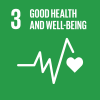
Goal 3. Ensure healthy lives and promote well-being for all at all ages |
| Goals & targets | Indicators |
| 3.1 By 2030, reduce the global maternal mortality
ratio to less than 70 per 100,000 live births | 3.1.1 Maternal mortality ratio
3.1.2 Proportion of births attended by skilled health
personnel |
| 3.2 By 2030, end preventable deaths of newborns and
children under 5 years of age, with all countries aiming
to reduce neonatal mortality to at least as low as 12 per
1,000 live births and under-5 mortality to at least as low
as 25 per 1,000 live births | 3.2.1 Under-five mortality rate
3.2.2 Neonatal mortality rate
Report of the Inter-Agency and Expert Group on Sustainable
Development Goal Indicators (E/CN.3/2016/2/Rev.1)
5/25
Goals and targets (from the 2030 Agenda) Indicators |
| 3.3 By 2030, end the epidemics of AIDS, tuberculosis,
malaria and neglected tropical diseases and combat
hepatitis, water-borne diseases and other communicable
diseases | 3.3.1 Number of new HIV infections per 1,000
uninfected population, by sex, age and key populations
3.3.2 Tuberculosis incidence per 1,000 population
3.3.3 Malaria incidence per 1,000 population
3.3.4 Hepatitis B incidence per 100,000 population
3.3.5 Number of people requiring interventions
against neglected tropical diseases |
| 3.4 By 2030, reduce by one third premature mortality
from non-communicable diseases through prevention
and treatment and promote mental health and well-being | 3.4.1 Mortality rate attributed to cardiovascular
disease, cancer, diabetes or chronic respiratory disease
3.4.2 Suicide mortality rate |
| 3.5 Strengthen the prevention and treatment of
substance abuse, including narcotic drug abuse and
harmful use of alcohol | 3.5.1 Coverage of treatment interventions
(pharmacological, psychosocial and rehabilitation and
aftercare services) for substance use disorders
3.5.2 Harmful use of alcohol, defined according to
the national context as alcohol per capita consumption
(aged 15 years and older) within a calendar year in
litres of pure alcohol |
| 3.6 By 2020, halve the number of global deaths and
injuries from road traffic accidents | 3.6.1 Death rate due to road traffic injuries |
| 3.7 By 2030, ensure universal access to sexual and
reproductive health-care services, including for family
planning, information and education, and the integration
of reproductive health into national strategies and
programmes | 3.7.1 Proportion of women of reproductive age (aged
15-49 years) who have their need for family planning
satisfied with modern methods
3.7.2 Adolescent birth rate (aged 10-14 years; aged
15-19 years) per 1,000 women in that age group |
| 3.8 Achieve universal health coverage, including
financial risk protection, access to quality essential
health-care services and access to safe, effective, quality
and affordable essential medicines and vaccines for all | 3.8.1 Coverage of essential health services (defined
as the average coverage of essential services based on
tracer interventions that include reproductive,
maternal, newborn and child health, infectious
diseases, non-communicable diseases and service
capacity and access, among the general and the most
disadvantaged population)
3.8.2 Number of people covered by health insurance
or a public health system per 1,000 population |
| 3.9 By 2030, substantially reduce the number of
deaths and illnesses from hazardous chemicals and air,
water and soil pollution and contamination | 3.9.1 Mortality rate attributed to household and
ambient air pollution
3.9.2 Mortality rate attributed to unsafe water, unsafe
sanitation and lack of hygiene (exposure to unsafe
Water, Sanitation and Hygiene for All (WASH)
services)
Report of the Inter-Agency and Expert Group on Sustainable
Development Goal Indicators (E/CN.3/2016/2/Rev.1)
6/25
Goals and targets (from the 2030 Agenda) Indicators
3.9.3 Mortality rate attributed to unintentional
poisoning |
| 3.a Strengthen the implementation of the World
Health Organization Framework Convention on
Tobacco Control in all countries, as appropriate | 3.a.1 Age-standardized prevalence of current
tobacco use among persons aged 15 years and older |
| 3.b Support the research and development of vaccines
and medicines for the communicable and
non-communicable diseases that primarily affect
developing countries, provide access to affordable
essential medicines and vaccines, in accordance with the
Doha Declaration on the TRIPS Agreement and Public
Health, which affirms the right of developing countries
to use to the full the provisions in the Agreement on
Trade-Related Aspects of Intellectual Property Rights
regarding flexibilities to protect public health, and, in
particular, provide access to medicines for all | 3.b.1 Proportion of the population with access to
affordable medicines and vaccines on a sustainable
basis
3.b.2 Total net official development assistance to
medical research and basic health sectors |
| 3.c Substantially increase health financing and the
recruitment, development, training and retention of the
health workforce in developing countries, especially in
least developed countries and small island developing
States | 3.c.1 Health worker density and distribution |
| 3.d Strengthen the capacity of all countries, in
particular developing countries, for early warning, risk
reduction and management of national and global health
risks | 3.d.1 International Health Regulations (IHR)
capacity and health emergency preparedness |
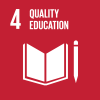
Goal 4. Ensure inclusive and equitable quality education and promote lifelong learning opportunities for all |
| Goals & targets | Indicators |
| 4.1 By 2030, ensure that all girls and boys complete
free, equitable and quality primary and secondary
education leading to relevant and effective learning
outcomes | 4.1.1 Proportion of children and young people:
(a) in grades 2/3; (b) at the end of primary; and
(c) at the end of lower secondary achieving at least a
minimum proficiency level in (i) reading and
(ii) mathematics, by sex |
| 4.2 By 2030, ensure that all girls and boys have access
to quality early childhood development, care and
pre-primary education so that they are ready for primary
education | 4.2.1 Proportion of children under 5 years of age
who are developmentally on track in health, learning
and psychosocial well-being, by sex
4.2.2 Participation rate in organized learning (one
year before the official primary entry age), by sex |
| 4.3 By 2030, ensure equal access for all women and
men to affordable and quality technical, vocational and
tertiary education, including university | 4.3.1 Participation rate of youth and adults in formal
and non-formal education and training in the previous
12 months, by sex |
| 4.4 By 2030, substantially increase the number of
youth and adults who have relevant skills, including
technical and vocational skills, for employment, decent
jobs and entrepreneurship | 4.4.1 Proportion of youth and adults with
information and communications technology (ICT)
skills, by type of skill
Report of the Inter-Agency and Expert Group on Sustainable
Development Goal Indicators (E/CN.3/2016/2/Rev.1)
7/25
Goals and targets (from the 2030 Agenda) Indicators |
| 4.5 By 2030, eliminate gender disparities in education
and ensure equal access to all levels of education and
vocational training for the vulnerable, including persons
with disabilities, indigenous peoples and children in
vulnerable situations | 4.5.1 Parity indices (female/male, rural/urban,
bottom/top wealth quintile and others such as
disability status, indigenous peoples and conflictaffected,
as data become available) for all education
indicators on this list that can be disaggregated |
| 4.6 By 2030, ensure that all youth and a substantial
proportion of adults, both men and women, achieve
literacy and numeracy | 4.6.1 Percentage of population in a given age group
achieving at least a fixed level of proficiency in
functional (a) literacy and (b) numeracy skills, by sex |
| 4.7 By 2030, ensure that all learners acquire the
knowledge and skills needed to promote sustainable
development, including, among others, through
education for sustainable development and sustainable
lifestyles, human rights, gender equality, promotion of a
culture of peace and non-violence, global citizenship
and appreciation of cultural diversity and of culture's
contribution to sustainable development | 4.7.1 Extent to which (i) global citizenship education
and (ii) education for sustainable development,
including gender equality and human rights, are
mainstreamed at all levels in: (a) national education
policies, (b) curricula, (c) teacher education and
(d) student assessment |
| 4.a Build and upgrade education facilities that are
child, disability and gender sensitive and provide safe,
non-violent, inclusive and effective learning
environments for all | 4.a.1 Proportion of schools with access to:
(a) electricity; (b) the Internet for pedagogical
purposes; (c) computers for pedagogical purposes;
(d) adapted infrastructure and materials for students
with disabilities; (e) basic drinking water; (f) singlesex
basic sanitation facilities; and (g) basic
handwashing facilities (as per the WASH indicator
definitions) |
| 4.b By 2020, substantially expand globally the number
of scholarships available to developing countries, in
particular least developed countries, small island
developing States and African countries, for enrolment
in higher education, including vocational training and
information and communications technology, technical,
engineering and scientific programmes, in developed
countries and other developing countries | 4.b.1 Volume of official development assistance
flows for scholarships by sector and type of study |
| 4.c By 2030, substantially increase the supply of
qualified teachers, including through international
cooperation for teacher training in developing countries,
especially least developed countries and small island
developing States | 4.c.1 Proportion of teachers in: (a) pre-primary;
(b) primary; (c) lower secondary; and (d) upper
secondary education who have received at least the
minimum organized teacher training (e.g. pedagogical
training) pre-service or in-service required for
teaching at the relevant level in a given country
|
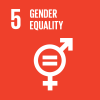
Goal 5. Achieve gender equality and empower all women and girls |
| Goals & targets | Indicators |
| 5.1 End all forms of discrimination against all women
and girls everywhere | 5.1.1 Whether or not legal frameworks are in place
to promote, enforce and monitor equality and
non-discrimination on the basis of sex
Report of the Inter-Agency and Expert Group on Sustainable
Development Goal Indicators (E/CN.3/2016/2/Rev.1)
8/25
Goals and targets (from the 2030 Agenda) Indicators |
| 5.2 Eliminate all forms of violence against all women
and girls in the public and private spheres, including
trafficking and sexual and other types of exploitation | 5.2.1 Proportion of ever-partnered women and girls
aged 15 years and older subjected to physical, sexual
or psychological violence by a current or former
intimate partner in the previous 12 months, by form of
violence and by age
5.2.2 Proportion of women and girls aged 15 years
and older subjected to sexual violence by persons
other than an intimate partner in the previous
12 months, by age and place of occurrence |
| 5.3 Eliminate all harmful practices, such as child,
early and forced marriage and female genital mutilation | 5.3.1 Proportion of women aged 20-24 years who
were married or in a union before age 15 and before
age 18
5.3.2 Proportion of girls and women aged 15-49 years
who have undergone female genital mutilation/cutting,
by age |
| 5.4 Recognize and value unpaid care and domestic
work through the provision of public services,
infrastructure and social protection policies and the
promotion of shared responsibility within the household
and the family as nationally appropriate | 5.4.1 Proportion of time spent on unpaid domestic
and care work, by sex, age and location |
| 5.5 Ensure women's full and effective participation
and equal opportunities for leadership at all levels of
decision-making in political, economic and public life | 5.5.1 Proportion of seats held by women in national
parliaments and local governments
5.5.2 Proportion of women in managerial positions |
| 5.6 Ensure universal access to sexual and reproductive
health and reproductive rights as agreed in accordance
with the Programme of Action of the International
Conference on Population and Development and the
Beijing Platform for Action and the outcome documents
of their review conferences | 5.6.1 Proportion of women aged 15-49 years who
make their own informed decisions regarding sexual
relations, contraceptive use and reproductive health
care
5.6.2 Number of countries with laws and regulations
that guarantee women aged 15-49 years access to
sexual and reproductive health care, information and
education |
| 5.a Undertake reforms to give women equal rights to
economic resources, as well as access to ownership and
control over land and other forms of property, financial
services, inheritance and natural resources, in
accordance with national laws | 5.a.1 (a) Proportion of total agricultural population
with ownership or secure rights over agricultural land,
by sex; and (b) share of women among owners or
rights-bearers of agricultural land, by type of tenure
5.a.2 Proportion of countries where the legal
framework (including customary law) guarantees
women's equal rights to land ownership and/or control |
| 5.b Enhance the use of enabling technology, in
particular information and communications technology,
to promote the empowerment of women | 5.b.1 Proportion of individuals who own a mobile
telephone, by sex
Report of the Inter-Agency and Expert Group on Sustainable
Development Goal Indicators (E/CN.3/2016/2/Rev.1)
9/25
Goals and targets (from the 2030 Agenda) Indicators |
| 5.c Adopt and strengthen sound policies and
enforceable legislation for the promotion of gender
equality and the empowerment of all women and girls at
all levels | 5.c.1 Proportion of countries with systems to track
and make public allocations for gender equality and
women's empowerment |
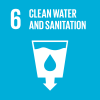
Goal 6. Ensure availability and sustainable management of water and sanitation for all |
| Goals & targets | Indicators |
| 6.1 By 2030, achieve universal and equitable access to
safe and affordable drinking water for all | 6.1.1 Proportion of population using safely managed
drinking water services |
| 6.2 By 2030, achieve access to adequate and equitable
sanitation and hygiene for all and end open defecation,
paying special attention to the needs of women and girls
and those in vulnerable situations | 6.2.1 Proportion of population using safely managed
sanitation services, including a hand-washing facility
with soap and water |
| 6.3 By 2030, improve water quality by reducing
pollution, eliminating dumping and minimizing release
of hazardous chemicals and materials, halving the
proportion of untreated wastewater and substantially
increasing recycling and safe reuse globally | 6.3.1 Proportion of wastewater safely treated
6.3.2 Proportion of bodies of water with good
ambient water quality |
| 6.4 By 2030, substantially increase water-use
efficiency across all sectors and ensure sustainable
withdrawals and supply of freshwater to address water
scarcity and substantially reduce the number of people
suffering from water scarcity | 6.4.1 Change in water-use efficiency over time
6.4.2 Level of water stress: freshwater withdrawal as
a proportion of available freshwater resources |
| 6.5 By 2030, implement integrated water resources
management at all levels, including through
transboundary cooperation as appropriate | 6.5.1 Degree of integrated water resources
management implementation (0-100)
6.5.2 Proportion of transboundary basin area with an
operational arrangement for water cooperation |
| 6.6 By 2020, protect and restore water-related
ecosystems, including mountains, forests, wetlands,
rivers, aquifers and lakes | 6.6.1 Change in the extent of water-related
ecosystems over time |
| 6.a By 2030, expand international cooperation and
capacity-building support to developing countries in
water- and sanitation-related activities and programmes,
including water harvesting, desalination, water
efficiency, wastewater treatment, recycling and reuse
technologies | 6.a.1 Amount of water- and sanitation-related
official development assistance that is part of a
government-coordinated spending plan |
| 6.b Support and strengthen the participation of local
communities in improving water and sanitation
management | 6.b.1 Proportion of local administrative units with
established and operational policies and procedures
for participation of local communities in water and
sanitation management
Report of the Inter-Agency and Expert Group on Sustainable
Development Goal Indicators (E/CN.3/2016/2/Rev.1)
10/25
Goals and targets (from the 2030 Agenda) Indicators |
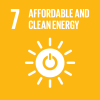
Goal 7. Ensure access to affordable, reliable, sustainable and modern energy for all |
| Goals & targets | Indicators |
| 7.1 By 2030, ensure universal access to affordable,
reliable and modern energy services | 7.1.1 Proportion of population with access to
electricity
7.1.2 Proportion of population with primary reliance
on clean fuels and technology |
| 7.2 By 2030, increase substantially the share of
renewable energy in the global energy mix | 7.2.1 Renewable energy share in the total final
energy consumption |
| 7.3 By 2030, double the global rate of improvement in
energy efficiency | 7.3.1 Energy intensity measured in terms of primary
energy and GDP |
| 7.a By 2030, enhance international cooperation to
facilitate access to clean energy research and
technology, including renewable energy, energy
efficiency and advanced and cleaner fossil-fuel
technology, and promote investment in energy
infrastructure and clean energy technology | 7.a.1 Mobilized amount of United States dollars per
year starting in 2020 accountable towards the
$100 billion commitment |
| 7.b By 2030, expand infrastructure and upgrade
technology for supplying modern and sustainable energy
services for all in developing countries, in particular
least developed countries, small island developing States
and landlocked developing countries, in accordance with
their respective programmes of support | 7.b.1 Investments in energy efficiency as a
percentage of GDP and the amount of foreign direct
investment in financial transfer for infrastructure and
technology to sustainable development services |
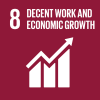
Goal 8. Promote sustained, inclusive and sustainable economic growth, full and productive employment
and decent work for all |
| Goals & targets | Indicators |
| 8.1 Sustain per capita economic growth in accordance
with national circumstances and, in particular, at least
7 per cent gross domestic product growth per annum in
the least developed countries | 8.1.1 Annual growth rate of real GDP per capita |
| 8.2 Achieve higher levels of economic productivity
through diversification, technological upgrading and
innovation, including through a focus on high-value
added and labour-intensive sectors | 8.2.1 Annual growth rate of real GDP per employed
person |
| 8.3 Promote development-oriented policies that
support productive activities, decent job creation,
entrepreneurship, creativity and innovation, and
encourage the formalization and growth of micro-,
small- and medium-sized enterprises, including through
access to financial services | 8.3.1 Proportion of informal employment in
non-agriculture employment, by sex |
|
Report of the Inter-Agency and Expert Group on Sustainable
Development Goal Indicators (E/CN.3/2016/2/Rev.1)
11/25
Goals and targets (from the 2030 Agenda) Indicators |
| 8.4 Improve progressively, through 2030, global
resource efficiency in consumption and production and
endeavour to decouple economic growth from
environmental degradation, in accordance with the
10-Year Framework of Programmes on Sustainable
Consumption and Production, with developed countries
taking the lead | 8.4.1 Material footprint, material footprint per
capita, and material footprint per GDP
8.4.2 Domestic material consumption, domestic
material consumption per capita, and domestic
material consumption per GDP |
| 8.5 By 2030, achieve full and productive employment
and decent work for all women and men, including for
young people and persons with disabilities, and equal
pay for work of equal value | 8.5.1 Average hourly earnings of female and male
employees, by occupation, age and persons with
disabilities
8.5.2 Unemployment rate, by sex, age and persons
with disabilities |
| 8.6 By 2020, substantially reduce the proportion of
youth not in employment, education or training | 8.6.1 Proportion of youth (aged 15-24 years) not in
education, employment or training |
| 8.7 Take immediate and effective measures to
eradicate forced labour, end modern slavery and human
trafficking and secure the prohibition and elimination of
the worst forms of child labour, including recruitment
and use of child soldiers, and by 2025 end child labour
in all its forms | 8.7.1 Proportion and number of children aged
5-17 years engaged in child labour, by sex and age |
| 8.8 Protect labour rights and promote safe and secure
working environments for all workers, including
migrant workers, in particular women migrants, and
those in precarious employment | 8.8.1 Frequency rates of fatal and non-fatal
occupational injuries, by sex and migrant status
8.8.2 Increase in national compliance of labour
rights (freedom of association and collective
bargaining) based on International Labour
Organization (ILO) textual sources and national
legislation, by sex and migrant status |
| 8.9 By 2030, devise and implement policies to
promote sustainable tourism that creates jobs and
promotes local culture and products | 8.9.1 Tourism direct GDP as a proportion of total
GDP and in growth rate
8.9.2 Number of jobs in tourism industries as a
proportion of total jobs and growth rate of jobs, by sex |
| 8.10 Strengthen the capacity of domestic financial
institutions to encourage and expand access to banking,
insurance and financial services for all | 8.10.1 Number of commercial bank branches and
automated teller machines (ATMs) per 100,000 adults
8.10.2 Proportion of adults (15 years and older) with
an account at a bank or other financial institution or
with a mobile-money-service provider |
| 8.a Increase Aid for Trade support for developing
countries, in particular least developed countries,
including through the Enhanced Integrated Framework
for Trade-related Technical Assistance to Least
Developed Countries | 8.a.1 Aid for Trade commitments and disbursements
Report of the Inter-Agency and Expert Group on Sustainable
Development Goal Indicators (E/CN.3/2016/2/Rev.1)
12/25
Goals and targets (from the 2030 Agenda) Indicators |
| 8.b By 2020, develop and operationalize a global
strategy for youth employment and implement the
Global Jobs Pact of the International Labour
Organization | 8.b.1 Total government spending in social protection
and employment programmes as a proportion of the
national budgets and GDP |
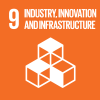
Goal 9. Build resilient infrastructure, promote inclusive and sustainable industrialization and
foster innovation |
| Goals & targets | Indicators |
| 9.1 Develop quality, reliable, sustainable and resilient
infrastructure, including regional and trans-border
infrastructure, to support economic development and
human well-being, with a focus on affordable and
equitable access for all | 9.1.1 Proportion of the rural population who live
within 2 km of an all-season road
9.1.2 Passenger and freight volumes, by mode of
transport |
| 9.2 Promote inclusive and sustainable industrialization
and, by 2030, significantly raise industry's share of
employment and gross domestic product, in line with
national circumstances, and double its share in least
developed countries | 9.2.1 Manufacturing value added as a proportion of
GDP and per capita
9.2.2 Manufacturing employment as a proportion of
total employment |
| 9.3 Increase the access of small-scale industrial and
other enterprises, in particular in developing countries,
to financial services, including affordable credit, and
their integration into value chains and markets | 9.3.1 Proportion of small-scale industries in total
industry value added
9.3.2 Proportion of small-scale industries with a loan
or line of credit |
| 9.4 By 2030, upgrade infrastructure and retrofit
industries to make them sustainable, with increased
resource-use efficiency and greater adoption of clean
and environmentally sound technologies and industrial
processes, with all countries taking action in accordance
with their respective capabilities | 9.4.1 CO2 emission per unit of value added |
| 9.5 Enhance scientific research, upgrade the
technological capabilities of industrial sectors in all
countries, in particular developing countries, including,
by 2030, encouraging innovation and substantially
increasing the number of research and development
workers per 1 million people and public and private
research and development spending | 9.5.1 Research and development expenditure as a
proportion of GDP
9.5.2 Researchers (in full-time equivalent) per
million inhabitants |
| 9.a Facilitate sustainable and resilient infrastructure
development in developing countries through enhanced
financial, technological and technical support to African
countries, least developed countries, landlocked
developing countries and small island developing States | 9.a.1 Total official international support (official
development assistance plus other official flows) to
infrastructure |
| 9.b Support domestic technology development,
research and innovation in developing countries,
including by ensuring a conducive policy environment
for, inter alia, industrial diversification and value
addition to commodities | 9.b.1 Proportion of medium and high-tech industry
value added in total value added
Report of the Inter-Agency and Expert Group on Sustainable
Development Goal Indicators (E/CN.3/2016/2/Rev.1)
13/25
Goals and targets (from the 2030 Agenda) Indicators |
| 9.c Significantly increase access to information and
communications technology and strive to provide
universal and affordable access to the Internet in least
developed countries by 2020 | 9.c.1 Proportion of population covered by a mobile
network, by technology |
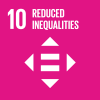
Goal 10. Reduce inequality within and among countries
 |
| Goals & targets | Indicators |
| 10.1 By 2030, progressively achieve and sustain
income growth of the bottom 40 per cent of the
population at a rate higher than the national average | 10.1.1 Growth rates of household expenditure or
income per capita among the bottom 40 per cent of the
population and the total population |
| 10.2 By 2030, empower and promote the social,
economic and political inclusion of all, irrespective of
age, sex, disability, race, ethnicity, origin, religion or
economic or other status | 10.2.1 Proportion of people living below 50 per cent
of median income, by age, sex and persons with
disabilities |
| 10.3 Ensure equal opportunity and reduce inequalities
of outcome, including by eliminating discriminatory
laws, policies and practices and promoting appropriate
legislation, policies and action in this regard | 10.3.1 Proportion of the population reporting having
personally felt discriminated against or harassed
within the previous 12 months on the basis of a
ground of discrimination prohibited under
international human rights law |
| 10.4 Adopt policies, especially fiscal, wage and social
protection policies, and progressively achieve greater
equality | 10.4.1 Labour share of GDP, comprising wages and
social protection transfers |
| 10.5 Improve the regulation and monitoring of global
financial markets and institutions and strengthen the
implementation of such regulations | 10.5.1 Financial Soundness Indicators |
| 10.6 Ensure enhanced representation and voice for
developing countries in decision-making in global
international economic and financial institutions in
order to deliver more effective, credible, accountable
and legitimate institutions | 10.6.1 Proportion of members and voting rights of
developing countries in international organizations |
| 10.7 Facilitate orderly, safe, regular and responsible
migration and mobility of people, including through the
implementation of planned and well-managed migration
policies | 10.7.1 Recruitment cost borne by employee as a
proportion of yearly income earned in country of
destination
10.7.2 Number of countries that have implemented
well-managed migration policies |
| 10.a Implement the principle of special and differential
treatment for developing countries, in particular least
developed countries, in accordance with World Trade
Organization agreements | 10.a.1 Proportion of tariff lines applied to imports
from least developed countries and developing
countries with zero-tariff
Report of the Inter-Agency and Expert Group on Sustainable
Development Goal Indicators (E/CN.3/2016/2/Rev.1)
14/25
Goals and targets (from the 2030 Agenda) Indicators |
| 10.b Encourage official development assistance and
financial flows, including foreign direct investment, to
States where the need is greatest, in particular least
developed countries, African countries, small island
developing States and landlocked developing countries,
in accordance with their national plans and programmes | 10.b.1 Total resource flows for development, by
recipient and donor countries and type of flow
(e.g. official development assistance, foreign direct
investment and other flows) |
| 10.c By 2030, reduce to less than 3 per cent the
transaction costs of migrant remittances and eliminate
remittance corridors with costs higher than 5 per cent | 10.c.1 Remittance costs as a proportion of the amount
remitted |

Goal 11. Make cities and human settlements inclusive, safe, resilient and sustainable |
| Goals & targets | Indicators |
| 11.1 By 2030, ensure access for all to adequate, safe
and affordable housing and basic services and upgrade
slums | 11.1.1 Proportion of urban population living in slums,
informal settlements or inadequate housing |
| 11.2 By 2030, provide access to safe, affordable,
accessible and sustainable transport systems for all,
improving road safety, notably by expanding public
transport, with special attention to the needs of those in
vulnerable situations, women, children, persons with
disabilities and older persons | 11.2.1 Proportion of population that has convenient
access to public transport, by sex, age and persons
with disabilities |
| 11.3 By 2030, enhance inclusive and sustainable
urbanization and capacity for participatory, integrated
and sustainable human settlement planning and
management in all countries | 11.3.1 Ratio of land consumption rate to population
growth rate
11.3.2 Proportion of cities with a direct participation
structure of civil society in urban planning and
management that operate regularly and democratically |
| 11.4 Strengthen efforts to protect and safeguard the
world's cultural and natural heritage | 11.4.1 Total expenditure (public and private) per
capita spent on the preservation, protection and
conservation of all cultural and natural heritage, by
type of heritage (cultural, natural, mixed and World
Heritage Centre designation), level of government
(national, regional and local/municipal), type of
expenditure (operating expenditure/investment) and
type of private funding (donations in kind, private
non-profit sector and sponsorship) |
| 11.5 By 2030, significantly reduce the number of
deaths and the number of people affected and
substantially decrease the direct economic losses
relative to global gross domestic product caused by
disasters, including water-related disasters, with a focus
on protecting the poor and people in vulnerable
situations | 11.5.1 Number of deaths, missing persons and persons
affected by disaster per 100,000 peoplea
11.5.2 Direct disaster economic loss in relation to
global GDP, including disaster damage to critical
infrastructure and disruption of basic servicesa
Report of the Inter-Agency and Expert Group on Sustainable
Development Goal Indicators (E/CN.3/2016/2/Rev.1)
15/25
Goals and targets (from the 2030 Agenda) Indicators |
| 11.6 By 2030, reduce the adverse per capita
environmental impact of cities, including by paying
special attention to air quality and municipal and other
waste management | 11.6.1 Proportion of urban solid waste regularly
collected and with adequate final discharge out of
total urban solid waste generated, by cities
11.6.2 Annual mean levels of fine particulate matter
(e.g. PM2.5 and PM10) in cities (population weighted) |
| 11.7 By 2030, provide universal access to safe,
inclusive and accessible, green and public spaces, in
particular for women and children, older persons and
persons with disabilities | 11.7.1 Average share of the built-up area of cities that
is open space for public use for all, by sex, age and
persons with disabilities
11.7.2 Proportion of persons victim of physical or
sexual harassment, by sex, age, disability status and
place of occurrence, in the previous 12 months |
| 11.a Support positive economic, social and
environmental links between urban, peri-urban and rural
areas by strengthening national and regional
development planning | 11.a.1 Proportion of population living in cities that
implement urban and regional development plans
integrating population projections and resource needs,
by size of city |
| 11.b By 2020, substantially increase the number of
cities and human settlements adopting and
implementing integrated policies and plans towards
inclusion, resource efficiency, mitigation and adaptation
to climate change, resilience to disasters, and develop
and implement, in line with the Sendai Framework for
Disaster Risk Reduction 2015-2030, holistic disaster
risk management at all levels | 11.b.1 Proportion of local governments that adopt and
implement local disaster risk reduction strategies in
line with the Sendai Framework for Disaster Risk
Reduction 2015-2030a
11.b.2 Number of countries with national and local
disaster risk reduction strategiesa |
| 11.c Support least developed countries, including
through financial and technical assistance, in building
sustainable and resilient buildings utilizing local
materials | 11.c.1 Proportion of financial support to the least
developed countries that is allocated to the
construction and retrofitting of sustainable, resilient
and resource-efficient buildings utilizing local
materials |
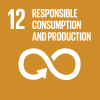
Goal 12. Ensure sustainable consumption and production patterns |
| Goals & targets | Indicators |
| 12.1 Implement the 10-Year Framework of Programmes
on Sustainable Consumption and Production Patterns,
all countries taking action, with developed countries
taking the lead, taking into account the development
and capabilities of developing countries | 12.1.1 Number of countries with sustainable
consumption and production (SCP) national action
plans or SCP mainstreamed as a priority or a target
into national policies |
| 12.2 By 2030, achieve the sustainable management and
efficient use of natural resources | 12.2.1 Material footprint, material footprint per
capita, and material footprint per GDP
12.2.2 Domestic material consumption, domestic
material consumption per capita, and domestic
material consumption per GDP |
| 12.3 By 2030, halve per capita global food waste at the
retail and consumer levels and reduce food losses along
production and supply chains, including post-harvest
losses | 12.3.1 Global food loss index
Report of the Inter-Agency and Expert Group on Sustainable
Development Goal Indicators (E/CN.3/2016/2/Rev.1)
16/25
Goals and targets (from the 2030 Agenda) Indicators |
| 12.4 By 2020, achieve the environmentally sound
management of chemicals and all wastes throughout
their life cycle, in accordance with agreed international
frameworks, and significantly reduce their release to air,
water and soil in order to minimize their adverse
impacts on human health and the environment | 12.4.1 Number of parties to international multilateral
environmental agreements on hazardous waste, and
other chemicals that meet their commitments and
obligations in transmitting information as required by
each relevant agreement
12.4.2 Hazardous waste generated per capita and
proportion of hazardous waste treated, by type of
treatment |
| 12.5 By 2030, substantially reduce waste generation
through prevention, reduction, recycling and reuse | 12.5.1 National recycling rate, tons of material
recycled |
| 12.6 Encourage companies, especially large and
transnational companies, to adopt sustainable practices
and to integrate sustainability information into their
reporting cycle | 12.6.1 Number of companies publishing sustainability
reports |
| 12.7 Promote public procurement practices that are
sustainable, in accordance with national policies and
priorities | 12.7.1 Number of countries implementing sustainable
public procurement policies and action plans |
| 12.8 By 2030, ensure that people everywhere have the
relevant information and awareness for sustainable
development and lifestyles in harmony with nature | 12.8.1 Extent to which (i) global citizenship education
and (ii) education for sustainable development
(including climate change education) are
mainstreamed in (a) national education policies;
(b) curricula; (c) teacher education; and (d) student
assessment |
| 12.a Support developing countries to strengthen their
scientific and technological capacity to move towards
more sustainable patterns of consumption and
production | 12.a.1 Amount of support to developing countries on
research and development for sustainable consumption
and production and environmentally sound
technologies |
| 12.b Develop and implement tools to monitor
sustainable development impacts for sustainable
tourism that creates jobs and promotes local culture and
products | 12.b.1 Number of sustainable tourism strategies or
policies and implemented action plans with agreed
monitoring and evaluation tools |
| 12.c Rationalize inefficient fossil-fuel subsidies that
encourage wasteful consumption by removing market
distortions, in accordance with national circumstances,
including by restructuring taxation and phasing out
those harmful subsidies, where they exist, to reflect
their environmental impacts, taking fully into account
the specific needs and conditions of developing
countries and minimizing the possible adverse impacts
on their development in a manner that protects the poor
and the affected communities | 12.c.1 Amount of fossil-fuel subsidies per unit of
GDP (production and consumption) and as a
proportion of total national expenditure on fossil fuels
Report of the Inter-Agency and Expert Group on Sustainable
Development Goal Indicators (E/CN.3/2016/2/Rev.1)
17/25
Goals and targets (from the 2030 Agenda) Indicators |
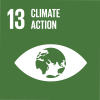
Goal 13. Take urgent action to combat climate change and its impactsb  |
| Goals & targets | Indicators |
| Goal 13. Take urgent action to combat climate change and its impactsb
13.1 Strengthen resilience and adaptive capacity to
climate-related hazards and natural disasters in all
countries | 13.1.1 Number of countries with national and local
disaster risk reduction strategiesa
13.1.2 Number of deaths, missing persons and persons
affected by disaster per 100,000 peoplea |
| 13.2 Integrate climate change measures into national
policies, strategies and planning | 13.2.1 Number of countries that have communicated
the establishment or operationalization of an
integrated policy/strategy/plan which increases their
ability to adapt to the adverse impacts of climate
change, and foster climate resilience and low
greenhouse gas emissions development in a manner
that does not threaten food production (including a
national adaptation plan, nationally determined
contribution, national communication, biennial update
report or other) |
| 13.3 Improve education, awareness-raising and human
and institutional capacity on climate change mitigation,
adaptation, impact reduction and early warning | 13.3.1 Number of countries that have integrated
mitigation, adaptation, impact reduction and early
warning into primary, secondary and tertiary curricula
13.3.2 Number of countries that have communicated
the strengthening of institutional, systemic and
individual capacity-building to implement adaptation,
mitigation and technology transfer, and development
actions |
| 13.a Implement the commitment undertaken by
developed-country parties to the United Nations
Framework Convention on Climate Change to a goal of
mobilizing jointly $100 billion annually by 2020 from
all sources to address the needs of developing countries
in the context of meaningful mitigation actions and
transparency on implementation and fully
operationalize the Green Climate Fund through its
capitalization as soon as possible | 13.a.1 Mobilized amount of United States dollars per
year starting in 2020 accountable towards the
$100 billion commitment |
| 13.b Promote mechanisms for raising capacity for
effective climate change-related planning and
management in least developed countries and small
island developing States, including focusing on women,
youth and local and marginalized communities | 13.b.1 Number of least developed countries and small
island developing States that are receiving specialized
support, and amount of support, including finance,
technology and capacity-building, for mechanisms for
raising capacities for effective climate change-related
planning and management, including focusing on
women, youth and local and marginalized
communities |
| b Acknowledging that the United Nations Framework Convention on Climate Change is the
primary international, intergovernmental forum for negotiating the global response to climate
change.
Report of the Inter-Agency and Expert Group on Sustainable
Development Goal Indicators (E/CN.3/2016/2/Rev.1)
18/25
Goals and targets (from the 2030 Agenda) Indicators |
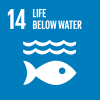
Goal 14. Conserve and sustainably use the oceans, seas and marine resources for sustainable development |
| Goals & targets | Indicators |
| 14.1 By 2025, prevent and significantly reduce marine
pollution of all kinds, in particular from land-based
activities, including marine debris and nutrient pollution | 14.1.1 Index of coastal eutrophication and floating
plastic debris density |
| 14.2 By 2020, sustainably manage and protect marine
and coastal ecosystems to avoid significant adverse
impacts, including by strengthening their resilience, and
take action for their restoration in order to achieve
healthy and productive oceans | 14.2.1 Proportion of national exclusive economic
zones managed using ecosystem-based approaches |
| 14.3 Minimize and address the impacts of ocean
acidification, including through enhanced scientific
cooperation at all levels | 14.3.1 Average marine acidity (pH) measured at
agreed suite of representative sampling stations |
| 14.4 By 2020, effectively regulate harvesting and end
overfishing, illegal, unreported and unregulated fishing
and destructive fishing practices and implement
science-based management plans, in order to restore
fish stocks in the shortest time feasible, at least to levels
that can produce maximum sustainable yield as
determined by their biological characteristics | 14.4.1 Proportion of fish stocks within biologically
sustainable levels |
| 14.5 By 2020, conserve at least 10 per cent of coastal
and marine areas, consistent with national and
international law and based on the best available
scientific information | 14.5.1 Coverage of protected areas in relation to
marine areas |
| 14.6 By 2020, prohibit certain forms of fisheries
subsidies which contribute to overcapacity and
overfishing, eliminate subsidies that contribute to
illegal, unreported and unregulated fishing and refrain
from introducing new such subsidies, recognizing that
appropriate and effective special and differential
treatment for developing and least developed countries
should be an integral part of the World Trade
Organization fisheries subsidies negotiationc | 14.6.1 Progress by countries in the degree of
implementation of international instruments aiming to
combat illegal, unreported and unregulated fishing |
| 14.7 By 2030, increase the economic benefits to small
island developing States and least developed countries
from the sustainable use of marine resources, including
through sustainable management of fisheries,
aquaculture and tourism | 14.7.1 Sustainable fisheries as a percentage of GDP in
small island developing States, least developed
countries and all countries |
| c Taking into account ongoing World Trade Organization negotiations, the Doha Development
Agenda and the Hong Kong ministerial mandate.
Report of the Inter-Agency and Expert Group on Sustainable
Development Goal Indicators (E/CN.3/2016/2/Rev.1)
19/25
Goals and targets (from the 2030 Agenda) Indicators |
| 14.a Increase scientific knowledge, develop research
capacity and transfer marine technology, taking into
account the Intergovernmental Oceanographic
Commission Criteria and Guidelines on the Transfer of
Marine Technology, in order to improve ocean health
and to enhance the contribution of marine biodiversity
to the development of developing countries, in
particular small island developing States and least
developed countries | 14.a.1 Proportion of total research budget allocated to
research in the field of marine technology |
| |
| 14.b Provide access for small-scale artisanal fishers to
marine resources and markets | 14.b.1 Progress by countries in the degree of
application of a legal/regulatory/policy/institutional
framework which recognizes and protects access
rights for small-scale fisheries |
| 14.c Enhance the conservation and sustainable use of
oceans and their resources by implementing
international law as reflected in the United Nations
Convention on the Law of the Sea, which provides the
legal framework for the conservation and sustainable
use of oceans and their resources, as recalled in
paragraph 158 of “The future we want” | 14.c.1 Number of countries making progress in
ratifying, accepting and implementing through legal,
policy and institutional frameworks, ocean-related
instruments that implement international law, as
reflected in the United Nation Convention on the Law
of the Sea, for the conservation and sustainable use of
the oceans and their resources |
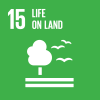
Goal 15. Protect, restore and promote sustainable use of terrestrial ecosystems, sustainably manage
forests, combat desertification, and halt and reverse land degradation and halt biodiversity loss |
| Goals & targets | Indicators |
| 15.1 By 2020, ensure the conservation, restoration and
sustainable use of terrestrial and inland freshwater
ecosystems and their services, in particular forests,
wetlands, mountains and drylands, in line with
obligations under international agreements | 15.1.1 Forest area as a proportion of total land area
15.1.2 Proportion of important sites for terrestrial and
freshwater biodiversity that are covered by protected
areas, by ecosystem type |
| 15.2 By 2020, promote the implementation of
sustainable management of all types of forests, halt
deforestation, restore degraded forests and substantially
increase afforestation and reforestation globally | 15.2.1 Progress towards sustainable forest
management |
| 15.3 By 2030, combat desertification, restore degraded
land and soil, including land affected by desertification,
drought and floods, and strive to achieve a land
degradation-neutral world | 15.3.1 Proportion of land that is degraded over total
land area |
| 15.4 By 2030, ensure the conservation of mountain
ecosystems, including their biodiversity, in order to
enhance their capacity to provide benefits that are
essential for sustainable development | 15.4.1 Coverage by protected areas of important sites
for mountain biodiversity
15.4.2 Mountain Green Cover Index |
| 15.5 Take urgent and significant action to reduce the
degradation of natural habitats, halt the loss of
biodiversity and, by 2020, protect and prevent the
extinction of threatened species | 15.5.1 Red List Index
Report of the Inter-Agency and Expert Group on Sustainable
Development Goal Indicators (E/CN.3/2016/2/Rev.1)
20/25
Goals and targets (from the 2030 Agenda) Indicators |
| 15.6 Promote fair and equitable sharing of the benefits
arising from the utilization of genetic resources and
promote appropriate access to such resources, as
internationally agreed | 15.6.1 Number of countries that have adopted
legislative, administrative and policy frameworks to
ensure fair and equitable sharing of benefits |
| 15.7 Take urgent action to end poaching and trafficking
of protected species of flora and fauna and address both
demand and supply of illegal wildlife products | 15.7.1 Proportion of traded wildlife that was poached
or illicitly trafficked |
| 15.8 By 2020, introduce measures to prevent the
introduction and significantly reduce the impact of
invasive alien species on land and water ecosystems and
control or eradicate the priority species | 15.8.1 Proportion of countries adopting relevant
national legislation and adequately resourcing the
prevention or control of invasive alien species |
| 15.9 By 2020, integrate ecosystem and biodiversity
values into national and local planning, development
processes, poverty reduction strategies and accounts | 15.9.1 Progress towards national targets established in
accordance with Aichi Biodiversity Target 2 of the
Strategic Plan for Biodiversity 2011-2020 |
| 15.a Mobilize and significantly increase financial
resources from all sources to conserve and sustainably
use biodiversity and ecosystems | 15.a.1 Official development assistance and public
expenditure on conservation and sustainable use of
biodiversity and ecosystems |
| 15.b Mobilize significant resources from all sources
and at all levels to finance sustainable forest
management and provide adequate incentives to
developing countries to advance such management,
including for conservation and reforestation | 15.b.1 Official development assistance and public
expenditure on conservation and sustainable use of
biodiversity and ecosystems |
| 15.c Enhance global support for efforts to combat
poaching and trafficking of protected species, including
by increasing the capacity of local communities to
pursue sustainable livelihood opportunities | 15.c.1 Proportion of traded wildlife that was poached
or illicitly trafficked |
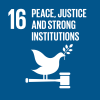
Goal 16. Promote peaceful and inclusive societies for sustainable development, provide access to justice for
all and build effective, accountable and inclusive institutions at all levels |
| Goals & targets | Indicators |
| 16.1 Significantly reduce all forms of violence and
related death rates everywhere | 16.1.1 Number of victims of intentional homicide per
100,000 population, by sex and age
16.1.2 Conflict-related deaths per 100,000 population,
by sex, age and cause
16.1.3 Proportion of population subjected to physical,
psychological or sexual violence in the previous 12 months
16.1.4 Proportion of population that feel safe walking
alone around the area they live |
| 16.2 End abuse, exploitation, trafficking and all forms
of violence against and torture of children | 16.2.1 Proportion of children aged 1-17 years who
experienced any physical punishment and/or
psychological aggression by caregivers in the past
month
Report of the Inter-Agency and Expert Group on Sustainable
Development Goal Indicators (E/CN.3/2016/2/Rev.1)
21/25
Goals and targets (from the 2030 Agenda) Indicators
16.2.2 Number of victims of human trafficking per
100,000 population, by sex, age and form of
exploitation
16.2.3 Proportion of young women and men aged
18-29 years who experienced sexual violence by
age 18 |
| 16.3 Promote the rule of law at the national and
international levels and ensure equal access to justice
for all | 16.3.1 Proportion of victims of violence in the
previous 12 months who reported their victimization
to competent authorities or other officially recognized
conflict resolution mechanisms
16.3.2 Unsentenced detainees as a proportion of
overall prison population
|
| 16.4 By 2030, significantly reduce illicit financial and
arms flows, strengthen the recovery and return of stolen
assets and combat all forms of organized crime | 16.4.1 Total value of inward and outward illicit
financial flows (in current United States dollars)
16.4.2 Proportion of seized small arms and light
weapons that are recorded and traced, in accordance
with international standards and legal instruments |
| 16.5 Substantially reduce corruption and bribery in all
their forms | 16.5.1 Proportion of persons who had at least one
contact with a public official and who paid a bribe to a
public official, or were asked for a bribe by those
public officials, during the previous 12 months
16.5.2 Proportion of businesses that had at least one
contact with a public official and that paid a bribe to a
public official, or were asked for a bribe by those
public officials during the previous 12 months |
| 16.6 Develop effective, accountable and transparent
institutions at all levels | 16.6.1 Primary government expenditures as a
proportion of original approved budget, by sector (or
by budget codes or similar)
16.6.2 Proportion of the population satisfied with their
last experience of public services |
| 16.7 Ensure responsive, inclusive, participatory and
representative decision-making at all levels | 16.7.1 Proportions of positions (by sex, age, persons
with disabilities and population groups) in public
institutions (national and local legislatures, public
service, and judiciary) compared to national
distributions
16.7.2 Proportion of population who believe decisionmaking
is inclusive and responsive, by sex, age,
disability and population group |
| 16.8 Broaden and strengthen the participation of
developing countries in the institutions of global
governance | 16.8.1 Proportion of members and voting rights of
developing countries in international organizations
Report of the Inter-Agency and Expert Group on Sustainable
Development Goal Indicators (E/CN.3/2016/2/Rev.1)
22/25
Goals and targets (from the 2030 Agenda) Indicators |
| 16.9 By 2030, provide legal identity for all, including
birth registration | 16.9.1 Proportion of children under 5 years of age
whose births have been registered with a civil
authority, by age |
| 16.10 Ensure public access to information and protect
fundamental freedoms, in accordance with national
legislation and international agreements | 16.10.1 Number of verified cases of killing,
kidnapping, enforced disappearance, arbitrary
detention and torture of journalists, associated media
personnel, trade unionists and human rights advocates
in the previous 12 months
16.10.2 Number of countries that adopt and implement
constitutional, statutory and/or policy guarantees for
public access to information |
| 16.a Strengthen relevant national institutions, including
through international cooperation, for building capacity
at all levels, in particular in developing countries, to
prevent violence and combat terrorism and crime | 16.a.1 Existence of independent national human rights
institutions in compliance with the Paris Principles
16.b Promote and enforce non-discriminatory laws and
policies for sustainable development
16.b.1 Proportion of population reporting having
personally felt discriminated against or harassed in the
previous 12 months on the basis of a ground of
discrimination prohibited under international human
rights law |
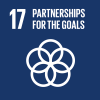
Goal 17. Strengthen the means of implementation and revitalize the Global Partnership for
Sustainable Development Finance |
| Goals & targets | Indicators |
| 17.1 Strengthen domestic resource mobilization,
including through international support to developing
countries, to improve domestic capacity for tax and
other revenue collection | 17.1.1 Total government revenue as a proportion of
GDP, by source
17.1.2 Proportion of domestic budget funded by
domestic taxes |
| 17.2 Developed countries to implement fully their
official development assistance commitments, including
the commitment by many developed countries to
achieve the target of 0.7 per cent of gross national
income for official development assistance (ODA/GNI)
to developing countries and 0.15 to 0.20 per cent of
ODA/GNI to least developed countries; ODA providers
are encouraged to consider setting a target to provide at
least 0.20 per cent of ODA/GNI to least developed
countries | 17.2.1 Net official development assistance, total and
to least developed countries, as a proportion of the
Organization for Economic Cooperation and
Development (OECD) Development Assistance
Committee donors' gross national income (GNI |
| 17.3 Mobilize additional financial resources for
developing countries from multiple sources | 17.3.1 Foreign direct investments (FDI), official
development assistance and South-South Cooperation
as a proportion of total domestic budget
17.3.2 Volume of remittances (in United States
dollars) as a proportion of total GDP
Report of the Inter-Agency and Expert Group on Sustainable
Development Goal Indicators (E/CN.3/2016/2/Rev.1)
23/25
Goals and targets (from the 2030 Agenda) Indicators |
| 17.4 Assist developing countries in attaining long-term
debt sustainability through coordinated policies aimed
at fostering debt financing, debt relief and debt
restructuring, as appropriate, and address the external
debt of highly indebted poor countries to reduce debt
distress | 17.4.1 Debt service as a proportion of exports of
goods and services |
| 17.5 Adopt and implement investment promotion
regimes for least developed countries | 17.5.1 Number of countries that adopt and implement
investment promotion regimes for least developed
countries
Technology |
| 17.6 Enhance North-South, South-South and triangular
regional and international cooperation on and access to
science, technology and innovation and enhance
knowledge-sharing on mutually agreed terms, including
through improved coordination among existing
mechanisms, in particular at the United Nations level,
and through a global technology facilitation mechanism | 17.6.1 Number of science and/or technology
cooperation agreements and programmes between
countries, by type of cooperation
17.6.2 Fixed Internet broadband subscriptions per
100 inhabitants, by speed |
| 17.7 Promote the development, transfer, dissemination
and diffusion of environmentally sound technologies to
developing countries on favourable terms, including on
concessional and preferential terms, as mutually agreed | 17.7.1 Total amount of approved funding for
developing countries to promote the development,
transfer, dissemination and diffusion of
environmentally sound technologies |
| 17.8 Fully operationalize the technology bank and
science, technology and innovation capacity-building
mechanism for least developed countries by 2017 and
enhance the use of enabling technology, in particular
information and communications technology | 17.8.1 Proportion of individuals using the Internet
Capacity-building |
| 17.9 Enhance international support for implementing
effective and targeted capacity-building in developing
countries to support national plans to implement all the
Sustainable Development Goals, including through
North-South, South-South and triangular cooperation | 17.9.1 Dollar value of financial and technical
assistance (including through North-South, South-
South and triangular cooperation) committed to
developing countries
Trade |
| 17.10 Promote a universal, rules-based, open,
non-discriminatory and equitable multilateral trading
system under the World Trade Organization, including
through the conclusion of negotiations under its Doha
Development Agenda | 17.10.1 Worldwide weighted tariff-average
Report of the Inter-Agency and Expert Group on Sustainable
Development Goal Indicators (E/CN.3/2016/2/Rev.1)
24/25
Goals and targets (from the 2030 Agenda) Indicators |
| 17.11 Significantly increase the exports of developing
countries, in particular with a view to doubling the least
developed countries' share of global exports by 2020 | 17.11.1 Developing countries' and least developed
countries' share of global exports |
| 17.12 Realize timely implementation of duty-free and
quota-free market access on a lasting basis for all least
developed countries, consistent with World Trade
Organization decisions, including by ensuring that
preferential rules of origin applicable to imports from
least developed countries are transparent and simple,
and contribute to facilitating market access | 17.12.1 Average tariffs faced by developing countries,
least developed countries and small island developing
States
Systemic issues
Policy and institutional coherence |
| 17.13 Enhance global macroeconomic stability,
including through policy coordination and policy
coherence | 17.13.1 Macroeconomic Dashboard |
| 17.14 Enhance policy coherence for sustainable
development | 17.14.1 Number of countries with mechanisms in
place to enhance policy coherence of sustainable
development |
| 17.15 Respect each country's policy space and
leadership to establish and implement policies for
poverty eradication and sustainable development | 17.15.1 Extent of use of country-owned results
frameworks and planning tools by providers of
development cooperation
Multi-stakeholder partnerships |
| 17.16 Enhance the Global Partnership for Sustainable
Development, complemented by multi-stakeholder
partnerships that mobilize and share knowledge,
expertise, technology and financial resources, to support
the achievement of the Sustainable Development Goals
in all countries, in particular developing countries | 17.16.1 Number of countries reporting progress in
multi-stakeholder development effectiveness
monitoring frameworks that support the achievement
of the sustainable development goals |
| 17.17 Encourage and promote effective public, publicprivate
and civil society partnerships, building on the experience and resourcing strategies of partnerships | 17.17.1 Amount of United States dollars committed to
public-private and civil society partnerships
Data, monitoring and accountability |
| 17.18 By 2020, enhance capacity-building support to
developing countries, including for least developed
countries and small island developing States, to increase
significantly the availability of high-quality, timely and
reliable data disaggregated by income, gender, age,
race, ethnicity, migratory status, disability, geographic
location and other characteristics relevant in national
contexts | 17.18.1 Proportion of sustainable development
indicators produced at the national level with full
disaggregation when relevant to the target, in
accordance with the Fundamental Principles of
Official Statistics
17.18.2 Number of countries that have national
statistical legislation that complies with the
Fundamental Principles of Official Statistics
Report of the Inter-Agency and Expert Group on Sustainable
Development Goal Indicators (E/CN.3/2016/2/Rev.1)
25/25
Goals and targets (from the 2030 Agenda) Indicators
17.18.3 Number of countries with a national statistical
plan that is fully funded and under implementation, by
source of funding |
| 17.19 By 2030, build on existing initiatives to develop
measurements of progress on sustainable development
that complement gross domestic product, and support
statistical capacity-building in developing countries | 17.19.1 Dollar value of all resources made available to
strengthen statistical capacity in developing countries
17.19.2 Proportion of countries that (a) have
conducted at least one population and housing census
in the last 10 years; and (b) have achieved 100 per
cent birth registration and 80 per cent death
registration |



